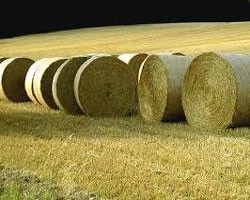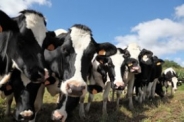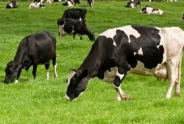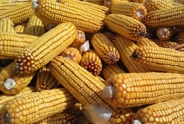Hay Storage Considerations, Don't Waste it!
Nancy Glazier, Small Farms & Livestock Specialist
Northwest New York Dairy, Livestock & Field Crops
Last Modified: June 4, 2013

With lost hay this season from armyworms and dry conditions, and high purchased feed prices, more of the bale will need to be utilized. Large bales are a convenient form of hay for one-person operations. These bales can be moved, stored and fed relatively easily with the right equipment. Hay loss can occur when baling, moving and feeding and some is unavoidable. The biggest loss - both dry matter and digestibility - occurs with outdoor storage. Dry matter loss can reach 50% depending on the beginning quality, storage conditions and length of storage. It is not always realistic or practical to build a barn to store hay. Here are some tips to minimize waste from outdoor storage.
Tightly wrapped bales tend to shed water better. The outer layer forms a thatch to reduce water infiltration. What helps with shedding precipitation is placing the bales lined up tightly together end to end. Pick a site that has good ventilation, away from hedgerows and wooded areas. This gives bales a better chance to dry out from air movement. And think about row spacing of at least 3 feet for good air flow and sunlight penetration. It's also a good idea to keep vegetation mowed between rows.
Ideally, bales should be stored off the ground. Hay stored directly on the ground may lose up to 12 inches on the bottom of the bales due to wicking action. Find some waste material such as old fence posts, pallets or tires and place the bales on top. Gravel or stone may work too. Research was conducted by University of Tennessee animal scientists comparing different methods of storing large round bales of grass hay. The hay was cut and baled in June in Tennessee. The bales were weighed at the time of harvest and storage. Then they were weighed again the following January at the time of winter feeding. The following table lists the type of storage and the resulting percentage hay loss.
Losses of Hay Stored using Six Methods of Storage
Note the difference between storage in the barn and on tires and covered. Some small changes can make a big difference! Plastic tarps can be relatively inexpensive when the saving from reducing loss is calculated
Type of Storage Percentage (%) Hay Loss
On ground, no cover 37%
On tires, no cover 29%
On ground, covered 29%
On tires, covered 8%
Net wrap on ground 19%
In barn 6%
Upcoming Events
2026 Corn Congress
January 14, 2026
Henrietta, NY
Participant Registration for the 2026 Corn Congress NOW OPEN!
NOW OFFERING 1.5 DEC Recertification CREDITS
2026 Forage Congress
January 28, 2026
Nunda, NY
More info to come
2026 Soybean & Small Grains Congress
February 11, 2026
Henrietta, NY
Announcements
The NWNY Team is Hiring!
The NWNY Dairy, Livestock and Field Crops Team is currently looking for an Area Dairy Management Specialist as well as a Small Farms and Livestock Specialist:The full position descriptions and instructions on how to apply are available here:
Area Dairy Management Specialist: https://academicjobsonline.org/ajo/jobs/31178
Small Farms and Livestock Specialist: https://academicjobsonline.org/ajo/jobs/30979
Follow us on Instagram
See photos and reels of our most recent events and programs!Join us on Facebook!
Follow us on Facebook to get up to date posts about events, workshops and everything NWNY!Add us on LinkedIn!
Connect with us on LinkedIn to get more information about upcoming workshops and programs!





